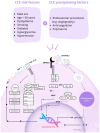The Controversial Role of Glucocorticoids in Atheroembolic Renal Disease: A Narrative Review
- PMID: 39518580
- PMCID: PMC11546646
- DOI: 10.3390/jcm13216441
The Controversial Role of Glucocorticoids in Atheroembolic Renal Disease: A Narrative Review
Abstract
Cholesterol crystal embolism (CCE) is an underrecognized multisystemic disease caused by the displacement of cholesterol crystals from atheromatous aortic plaques to distal vascular beds, leading to ischemic injury of target organs, particularly the kidneys, i.e., atheroembolic renal disease (ARD). According to recent research, cellular necrosis, induced by crystal-induced cytotoxicity, enhances the autoinflammatory cascade of the NLPR3 inflammasome, leading in turn to the so-called "necroinflammation". The purported involvement of the latter in CCE offers a rationale for the therapeutic approach with anti-inflammatory drugs such as glucocorticoids, the use of which has long been a matter of debate in CCE. Diagnostic delay and no consistent evidence regarding efficacious treatment, leading to inconsistency in clinical practice, may worsen the already poor prognosis of ARD. The possible role of glucocorticoids in the treatment of ARD is thereby herein explored in a narrative fashion, analyzing the limited data from case reports and clinical trials.
Keywords: acute kidney injury (AKI); atheroembolic renal disease (ARD); cholesterol crystal embolization (CCE); crystallopathies; glucocorticoids; necroinflammation.
Conflict of interest statement
The authors declare no conflicts of interest.
Figures
Similar articles
-
Cholesterol Crystal Embolism and Chronic Kidney Disease.Int J Mol Sci. 2017 May 24;18(6):1120. doi: 10.3390/ijms18061120. Int J Mol Sci. 2017. PMID: 28538699 Free PMC article. Review.
-
Idiopathic cholesterol crystal embolism with atheroembolic renal disease and blue toes syndrome: A case report.World J Clin Cases. 2022 Sep 6;10(25):9162-9167. doi: 10.12998/wjcc.v10.i25.9162. World J Clin Cases. 2022. PMID: 36157649 Free PMC article.
-
Cholesterol crystal embolism: A recognizable cause of renal disease.Am J Kidney Dis. 2000 Dec;36(6):1089-109. doi: 10.1053/ajkd.2000.19809. Am J Kidney Dis. 2000. PMID: 11096032 Review.
-
Atheroembolic Kidney Disease.2024 Jun 22. In: StatPearls [Internet]. Treasure Island (FL): StatPearls Publishing; 2025 Jan–. 2024 Jun 22. In: StatPearls [Internet]. Treasure Island (FL): StatPearls Publishing; 2025 Jan–. PMID: 29494024 Free Books & Documents.
-
[Atheroembolic renal disease].G Ital Nefrol. 2009 Mar-Apr;26(2):181-90. G Ital Nefrol. 2009. PMID: 19382074 Review. Italian.
References
-
- Fukumoto Y., Tsutsui H., Tsuchihashi M., Masumoto A., Takeshita A., Cholesterol Embolism Study(CHEST) Investigators The incidence and risk factors of cholesterol embolization syndrome, a complication of cardiac catheterization: A prospective study. J. Am. Coll. Cardiol. 2003;42:211–216. doi: 10.1016/S0735-1097(03)00579-5. - DOI - PubMed
Publication types
LinkOut - more resources
Full Text Sources


